 KPSC research draws global attention for COVID studies and more
KPSC research draws global attention for COVID studies and more
Research program shined during pandemic
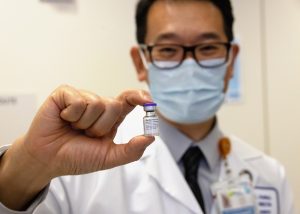 The World Health Organization declared the COVID-19 outbreak a global pandemic on March 11, 2020. On Saturday morning just a few days later, William Towner, MD, FACP, FIDSA, and Hai Linh Kerrigan, PharmD, the leaders of KPSC’s clinical trials program in R&E, huddled on a conference call. They discussed the feasibility of quickly launching a trial for an investigational drug called remdesivir, then considered a promising candidate for treatment of COVID-19.
The World Health Organization declared the COVID-19 outbreak a global pandemic on March 11, 2020. On Saturday morning just a few days later, William Towner, MD, FACP, FIDSA, and Hai Linh Kerrigan, PharmD, the leaders of KPSC’s clinical trials program in R&E, huddled on a conference call. They discussed the feasibility of quickly launching a trial for an investigational drug called remdesivir, then considered a promising candidate for treatment of COVID-19.
Time was of the essence. The pandemic was closing in. Within days, officials would declare it safer for Californians to stay home, as cases of COVID-19 began to climb in the state. No treatments were yet approved.
Just 8 days after that initial call, the remdesivir trial opened at 13 Kaiser Permanente medical centers in Southern California. The initiative took the collaboration of the clinical trials team and many physicians, pharmacists, nurses, and research staff across the region.
The jump into a clinical trial was just the beginning.
Rapid-cycle research
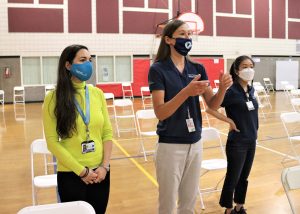 In those first months of the pandemic, scientists, clinicians, and staff fervently initiated research on the novel coronavirus. Much was unknown at the time. There were no approved treatments, much less a vaccine. Physicians lacked evidence to guide clinical decision-making.
In those first months of the pandemic, scientists, clinicians, and staff fervently initiated research on the novel coronavirus. Much was unknown at the time. There were no approved treatments, much less a vaccine. Physicians lacked evidence to guide clinical decision-making.
In April 2020, the Regional Research Committee and the Care Improvement Research Team joined forces to initiate a series of rapid-cycle research projects to answer real-word questions about the disease. One of them aimed to help physicians in emergency departments better assess which patients would benefit most from hospitalization. The project led to the development of the COVAS score, which was implemented in Kaiser Permanente HealthConnect in July 2020.
“The situation with COVID-19 highlighted the important role that research can play,” said Bechien U. Wu, MD, MPH, chair of the Regional Research Committee. “We were dealing with an entirely new disease, with many gaps in our knowledge.”
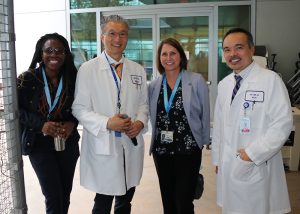 Scientists and clinician researchers initiated a wide range of studies to fill in the gaps in knowledge about the new disease. They studied how conditions like obesity, kidney disease, and cardiovascular disease affected the risk of severe COVID, how racial and ethnic inequities affected COVID-19 outcomes, and how physical activity could reduce the risk of poor COVID outcomes.
Scientists and clinician researchers initiated a wide range of studies to fill in the gaps in knowledge about the new disease. They studied how conditions like obesity, kidney disease, and cardiovascular disease affected the risk of severe COVID, how racial and ethnic inequities affected COVID-19 outcomes, and how physical activity could reduce the risk of poor COVID outcomes.
Researchers also examined the impact of the pandemic shutdown, including an 80% drop in cervical cancer screenings and a 9% increase in young children being considered overweight or obese. One study looked across the country to see where mask-wearing adherence was highest and what factors were involved.
Patients became participants to aid in COVID research
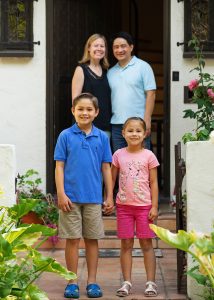 By late summer 2020, the KPSC clinical trials research team began enrolling participants in the trial for the Pfizer-BioNTech COVID-19 vaccine.
By late summer 2020, the KPSC clinical trials research team began enrolling participants in the trial for the Pfizer-BioNTech COVID-19 vaccine.
“By that time, more than 16 million people had been infected with COVID-19 around the globe. The pandemic had affected the world profoundly both economically and socially,” said Dr. Towner, who served as principal investigator for the vaccine trial in KPSC. “We knew it was imperative that we find a safe and effective vaccine as quickly as possible.”
By mid-November, preliminary results showed efficacy results of 95%. A month later, the FDA granted emergency use authorization. On December 14, the first COVID-19 vaccine administered outside of clinical trials in California was given at the Los Angeles Medical Center.
KPSC’s successful participation in the Pfizer-BioNTech trial paved the way for participation in additional Pfizer-BioNTech and Moderna COVID-19 vaccine studies in 2021, including 2 pediatric trials and a study assessing a vaccine booster dose in adults.
“Much as with the AIDS epidemic, the COVID-19 pandemic thrust a light on the importance of rapidly done, high-quality research to help bring critically needed therapies to the public,” said Dr. Towner. “It has been incredibly inspiring to see how many people have come together in this historic effort to bring the COVID-19 pandemic to an end.”
Vaccine makers sought KPSC’s expertise
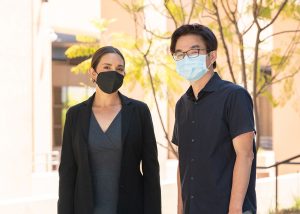 Vaccine makers weren’t interested in KPSC only as a place for clinical trials. As Pfizer-BioNTech and Moderna prepared to roll out new mRNA vaccines to the public, they each began discussions with the vaccine research team at KPSC. They realized that KPSC’s robust data and expertise in vaccine research made it a perfect place to get accurate, insightful vaccine studies up and running quickly.
Vaccine makers weren’t interested in KPSC only as a place for clinical trials. As Pfizer-BioNTech and Moderna prepared to roll out new mRNA vaccines to the public, they each began discussions with the vaccine research team at KPSC. They realized that KPSC’s robust data and expertise in vaccine research made it a perfect place to get accurate, insightful vaccine studies up and running quickly.
Sara Tartof, PhD, led a team working with Pfizer-BioNTech, and Hung Fu Tseng, PhD, led a team working with Moderna. KPSC was awarded large research contracts to study effectiveness of the Pfizer-BioNTech and Moderna vaccines against SARS-CoV-2 variants. The work was aided by a massive expansion of laboratory work that supported whole genome sequencing to identify the SARS-CoV-2 strain.
The work provided real-world evidence to policymakers about booster dose authorization and recommendations including meetings of expert advisory committees for the FDA and CDC. It also drew national and international media attention.
Global influence beyond COVID
While vaccine research from KPSC became a regular feature at advisory committees to the CDC and FDA during the pandemic, the influence of our research extended well beyond COVID.
In early 2023, the Institute for Clinical and Economic Review issued new policy recommendations for treatment of relapsing multiple sclerosis that included urging off-label use of rituximab to improve affordability and access to effective treatment. The World Health Organization followed suit a few months later, listing rituximab as an essential medicine for MS.
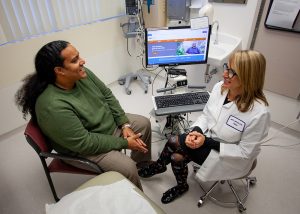 Both ICER and the WHO cited findings from a 2022 study led by Annette Langer-Gould, MD, PhD, a neuroscientist with SCPMG and affiliated investigator with R&E. The study found that relapse rates plummeted between 2012 to 2018, following the implementation of SCPMG’s MS Treatment Optimization Program. During the same time, the cost of treatment fell, partly due to the lower cost of rituximab.
Both ICER and the WHO cited findings from a 2022 study led by Annette Langer-Gould, MD, PhD, a neuroscientist with SCPMG and affiliated investigator with R&E. The study found that relapse rates plummeted between 2012 to 2018, following the implementation of SCPMG’s MS Treatment Optimization Program. During the same time, the cost of treatment fell, partly due to the lower cost of rituximab.
“In addition to being effective and affordable, it’s long lasting, so patients don’t need to come to the office as often. That also means more people tend to stick with treatment over time,” said Dr. Langer-Gould. “What’s more, research we conducted in collaboration with Sweden showed similar successes for patients. It really seems to be a game changer.”
As the research program moved into its 60th anniversary year, researchers were tapped to lead important new national initiatives. The Patient-Centered Outcomes Research Institute selected KPSC as 1 of 42 health systems nationwide to carry out a pioneering initiative aimed at improving patient outcomes. KPSC was also selected as 1 of 13 sites that will form Insight Net, a national initiative launched by the CDC’s Center for Forecasting and Outbreak Analytics.
New division established to support clinician researchers
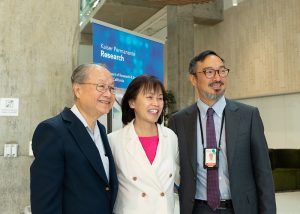 In 2023, the department announced a new Division of Clinician Research to improve support for and engagement of clinician researchers in KPSC. Bechien U. Wu, MD, MPH, is the physician director of the new division.
In 2023, the department announced a new Division of Clinician Research to improve support for and engagement of clinician researchers in KPSC. Bechien U. Wu, MD, MPH, is the physician director of the new division.
“Overall, the vision is to be a bridge between R&E and clinical operations to support the clinician research and streamline our programs to support them,” he said. “We also want to foster collaboration between clinicians and research scientists, expand research education for physicians, and promote the research that feeds back into the health care of our members.”
On a Saturday in late October, the new division hosted the inaugural SCPMG Research Summit, which drew participation from physicians from medical centers across the region. About 60 people, including physicians, scientists, and administrators attended the event, organized around “the intersection of clinical practice, research, and medical education.”
“We originally planned for a very small group, but there was a lot of momentum, and it grew into something much larger,” said Dr. Wu. “That so many people turned out on a Saturday really shows the high level of interest in connecting with other researchers.”
At the summit, the division launched a new research network to enable collaboration among clinician researchers with shared interests in clinical topics and research themes, such as health equity, artificial intelligence, and personalized medicine/genomics.
The network also hopes to identify high-priority areas for research with the potential to transform practice.
Searching for new scientists and a new executive director
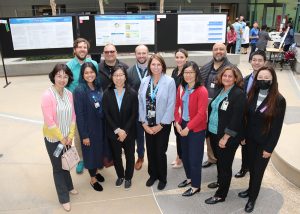 At end of 2023, R&E looks very different than the early days of research. It is home to 32 scientists and more than 500 staff. It supports hundreds of research projects and clinical trials across KPSC. Research funding approached $100 million — the vast majority from external grants and contracts — an exponential leap from the original budget of $10,000 in 1954.
At end of 2023, R&E looks very different than the early days of research. It is home to 32 scientists and more than 500 staff. It supports hundreds of research projects and clinical trials across KPSC. Research funding approached $100 million — the vast majority from external grants and contracts — an exponential leap from the original budget of $10,000 in 1954.
Having grown rapidly over the past decade and a half, R&E’s focus now is on expanding expertise in key strategic areas. One priority is to expand clinician research, particularly with a focus on implementation. The department is also adding new scientists with expertise in mental health research and health equity and expanding its vaccine research team.
Currently, the search is on for a permanent executive scientific director to replace Dr. Broder, who has served as interim scientific director since 2021. Dr. Haque is on the search committee, just as she was when Dr. Jacobsen was hired.
“It’s always an exciting time when new leadership comes aboard,” she said. “A new director can invigorate our department. Growth needs to happen and that’s often with one person leaving and a new person coming in. I’m sure our department’s growth and impact will continue.”
“It has been a great privilege to serve as interim leader for the department for the past few years and to witness the resilience and dedication of the people of R&E up close during an important historic moment. I have no doubt that our physicians and scientists will continue to transform the future of health for many years to come.”





